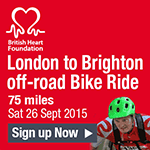Share the road with cyclists, AA urges 15 million members
20/05/2011 AdvocacyTransport for London and the AA have issued joint advice for cyclists and motorists, urging all to travel safely, within the law and with consideration for others.
TfL wrote the advice for cyclists and AA wrote the advice for motorists. Bike Hub editor Carlton Reid strengthened some of the advice before it was published, but can’t claim credit for the excellent final piece of AA advice that if you can’t beat ‘em, join ‘em: “Consider riding a bicycle for some of your own journeys…”
Here’s the AA’s advice to its 15 million members:
Cyclists have the same rights on the road and as a driver you should remember that you are sharing the road with cyclists.
Cyclists are more vulnerable than car users – take particular care near cyclists and give them plenty of room at all times.
Expect cyclists in unexpected places – always check your mirrors for cyclists before turning.
If you’re uncertain as to the intention of another road user – including cyclists – hold back rather than risk a wrong assumption.
Watch out for cyclists coming up on your near side when turning left or moving over to the left – check mirrors and blind spots carefully.
Allow at least a metre (a car door’s width) when overtaking cyclists – they may have to move out to avoid hazards like drains, potholes or debris on the road that you may not be able to see.
When parking check the door mirror and look behind you before you open the door to make sure you don’t hit a cyclist.
When turning left allow any cyclist ahead of you to pass the junction rather than overtake them and turn sharply across their front wheel.
Don’t overtake a cyclist if you can see that the road narrows ahead – if they’re travelling faster than you think you could end up squeezing them off the road.
Don’t drive aggressively around cyclists or sound your horn
Cyclists may be travelling faster than you think (could be 20mph plus) – judge their approaching speed with care before pulling out at a junction.
Take special care on roundabouts – you must give way to any vehicle approaching from the right and that includes cyclists.
Be prepared to wait behind a cyclist turning right in the same way you would for a car – rather than squeezing past or getting impatient.
Don’t park in cycle lanes – you could be forcing a cyclist into a dangerous situation and will be committing a road traffic offence if you drive or park in a cycle lane marked with a solid white line.
Don’t drive into the ‘advanced stop area’ for cyclists at lights – it is against the Highway Code.
Match your speed to the conditions and make sure you will be able to stop well within the distance that you can see to be clear – on country roads there could be a group of cyclists, a horse rider or pedestrians around the next bend.
At night, use dipped headlights when approaching cyclists as you would when approaching any other road user.
Allow cyclists extra room in wet weather as surfaces will be wet and slippery.
Consider riding a bicycle for some of your own journeys to get a better understanding of the risks cyclists face.
And here’s Transport for London’s advice to cyclists (note, there’s no suggestion that cyclists ought to take up driving instead, TfL doesn’t want gridlock):
Be aware of the driver’s blind spot when passing lorries and buses. It’s often safer to hang back.
Pay attention to what is going on around you and be aware of what other road users might do.
Try to make eye contact with drivers so that you know they have seen you.
Ride assertively, away from the gutter. If the road is too narrow for vehicles to pass you safely, it may be better to ride in the middle of the lane to prevent dangerous overtaking.
Ride in a straight line past parked cars, rather than dodge between them, and allow at least a full door’s width between you in case the doors are suddenly opened.
Wait in front of other vehicles at traffic lights. Use the advanced stop line for cyclists if there is one.
Don’t ride through red traffic lights. You may be fined £30.
Use appropriate hand signals when making a left or right turn.
Wear bright clothing in the day and reflective clothing or accessories at night.
Use lights after dark; white at the front and red at the rear. You may be fined £30 if you don’t have them.
Consider wearing a helmet.




